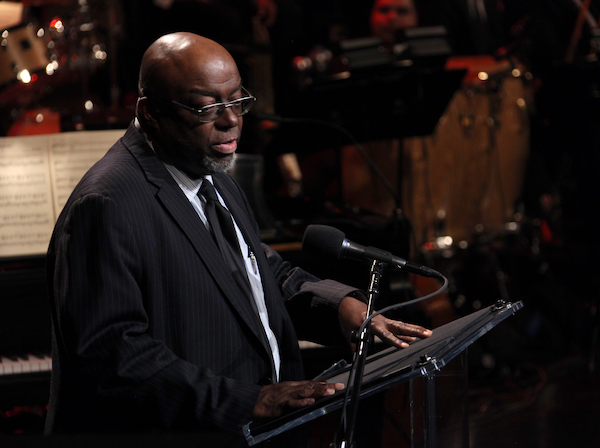Dec 9, 2025 12:28 PM
In Memoriam: Gordon Goodwin, 1954–2025
Gordon Goodwin, an award-winning saxophonist, pianist, bandleader, composer and arranger, died Dec. 8 in Los Angeles.…

Critic and author Stanley Crouch speaks at the 2012 NEA Jazz Masters ceremony.
(Photo: Michael G. Stewart)If we’re all still struggling to define what “jazz” is—or if it’s even necessary to land on an answer—Stanley Crouch’s life traced the contours of that conversation, and in some ways, led it.
Crouch, a critic and writer who was as erudite as he was divisive, died Sept. 16 in New York at the age of 74.
He was a public figure for jazz during a time when the music found itself amid declining influence in American culture, and came to advocate for a traditional aesthetic that belied his connection to the avant-garde in the 1970s. Along with trumpeter Wynton Marsalis, Crouch helped conceptualize in 1987 what would become Jazz at Lincoln Center.
Crouch and Marsalis also appeared in the 2001 PBS documentary Jazz, directed by Ken Burns, where the pair focused on swing and blues as defining elements of the music.
The passion with which Crouch defended his perspective, though, sometimes overflowed into aggression; numerous accounts of physical confrontations with those he disagreed with have floated around the jazzworld for years. He reportedly was let go from a position at the Village Voice following an altercation with another writer.
Crouch, who became a NEA Jazz Master in 2019, also inexplicably outted pianist Cecil Taylor in the 1970s.
As much as he contributed to proper criticism and discussion of the music, he also pivoted and dissected the largely white group of critics who covered jazz, writing in a 2003 JazzTimes column, “Their job, they believe, is to speak up for the exotic Negro or use that Negro as a weapon against their own middle-class backgrounds or make that Negro into a symbol of their desire to do something bold, wild and outside of convention.”
He believed the stance resulted in being dismissed from the publication. It furthered discussions around the genre, but so did his book-length works.
“While Stanley was known—revered and rebuked—as a provocateur in several genres, two things may stand as testaments to his cultural impact: his relationship with Wynton Marsalis and their founding of Jazz at Lincoln Center, and the other, his biography Kansas City Lightning on the early years of Charlie ‘Yardbird’ Parker,” said Herb Boyd, an author, educator and DownBeat contributor.
Born in Los Angeles on Dec. 14, 1945, Crouch held a variety of college teaching positions in California prior to moving to New York in 1975, where his writing career and influence in jazz blossomed. He’s survived by his wife, the artist Gloria Nixon-Crouch. DB

Goodwin was one of the most acclaimed, successful and influential jazz musicians of his generation.
Dec 9, 2025 12:28 PM
Gordon Goodwin, an award-winning saxophonist, pianist, bandleader, composer and arranger, died Dec. 8 in Los Angeles.…

Belá Fleck during an interview with Fredrika Whitfield on CNN.
Jan 13, 2026 2:09 PM
The fallout from the renaming of the John F. Kennedy Center for the Performing Arts to include President Donald…

Flea has returned to his first instrument — the trumpet — and assembled a dream band of jazz musicians to record a new album.
Dec 2, 2025 2:01 AM
After a nearly five-decade career as one of his generation’s defining rock bassists, Flea has returned to his first…

Dec 11, 2025 11:00 AM
DownBeat presents a complete list of the 4-, 4½- and 5-star albums from 2025 in one convenient package. It’s a great…

“It’s a pleasure and an honor to interpret the music of Oscar Peterson in his native city,” said Jim Doxas in regard to celebrating the Canadian legend. “He traveled the world, but never forgot Montreal.”
Nov 18, 2025 12:16 PM
In the pantheon of jazz luminaries, few shine as brightly, or swing as hard, as Oscar Peterson. A century ago, a…